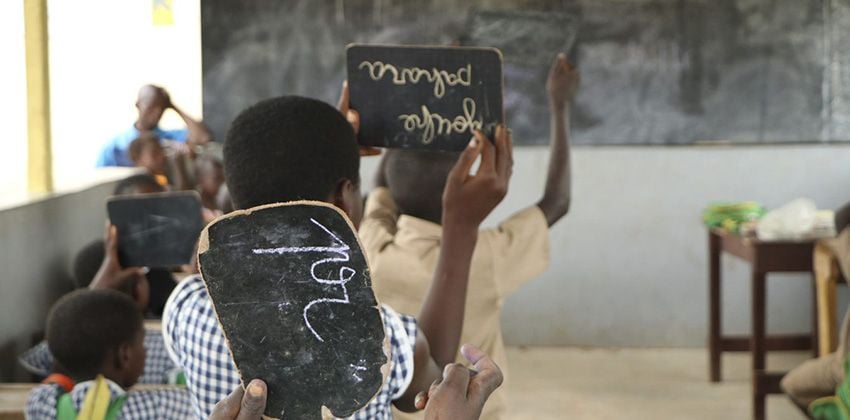According to UNICEF, over one million children work in cocoa plantations in Ivory Coast during harvest times. The time they spend working prevents them from going to school and this ultimately contributes to perpetuating the poverty cycle in cocoa-growing regions.
In order to tackle this issue, Nestlé and TRECC, the Jacobs Foundation’s program in Ivory Coast, have come together to create bridging classes for out-of-school children. Classrooms have been built in 35 Ivorian villages with the goal of increasing quality of education in these communities. This substantial endeavor is meant to give a second chance to children 9-14 who have been out of school for a while or who never even had the chance to go there in the first place. I could observe the situation myself in Binao, Western Ivory Coast. Here’s what I found.
Bridging Classes in Action
Binao is the village of Dissa Nafon, the first Ivorian producer of cocoa in 2017. The man alone claims 124 hectares of cocoa fields in this town 25 km away from the city of Duékoué. Once in Binao, the smell of pesticide testifies to the strong agricultural activity in this town where over 2,000 locals live. The village is practically empty today. Farmers are busy with weeding, planting and some harvesting in their plantations. The school holiday and the short cocoa harvest season have just begun, but a few students are sitting in a classroom in their uniforms. It is a small yellow building with a tin roof, set right next to the official school. “It’s not by chance that we’re right next to the village school. It is so that we facilitate a smooth integration of students back into the regular school cycle once they’ve completed a year in the bridging class,” says Nourgo Koné, field officer at TRECC.
Today, thirty students are in this class taking a math lesson. They are enthusiastic and eager to answer the teacher’s questions. They are all 9-14 year old sons or daughters of farmers. There is just one grade in this classroom, called UPC (Unified Preparatory Course), which combines curriculum elements from the first and second grade of primary school. The little Cyriac Yao, 9 years old, is the first in this class after managing to score the best grades. His father, Oufouet Marcelin Yao, a farmer in Binao since 1984, admits that his son has joined him in the plantation before to give him a hand. “The formal school is not completely free, so because I didn’t have the means to put him in school, and because I didn’t want to leave him alone all day at home, I took my son to the field. He did thinks like cooking lunch or bringing me water. No heavy task was imposed upon him. And since the bridging classes project started, I can leave him in school while I go to the field, because it’s free. He learns and is busy with something good,” says Mr. Oufouet, who is visibly relieved. He is a member of CAEG, a cooperative that produces 2,000 tonnes of cocoa per year.
The lessons
This wave of bridging classes – the second for Nestlé and TRECC- began on December 13, 2017 and it will end in August 2018. Lessons are held every weekday at the same time as formal school hours, and the focus is on reading, writing and mathematics. Learning levels for primary students in Ivory Coast are low, particularly in rural areas. According to a 2016 assessment conducted by the Ivorian Ministry of National Education, 77% of first-grade students had a reading level that was below expectations, and 80% of the students had not reached minimum proficiency levels in math. By functioning as an accelerated course where children can catch up with their expected skill levels, the bridging classes project works as a solution to this problem, according to Nourgo Koné.
After 9 months in the bridging class, children will undergo an evaluation supervised by the Ministry of National Education before they are put back into the formal education system. The best performing children will be transferred to fifth grade. Those performing in acceptable levels will be put into fourth grade, and the least performing will integrate third-grade classes.
The trainers
The bridging class teacher is a volunteer recruited by the International Cocoa Initiative (ICI), the implementing partner for this bridging classes project. Volunteers are community members for the most part. Charles Eric Ouphouet, who is in his twenties, leads the Binao class. He completed two years of high school in Duékoué. During a 2-week accelerated training ahead of joining the project, he learned to communicate as a teacher as well as some basic notions of French and math pedagogy. He is evaluated by ICI on a monthly basis to ensure his skills and methodology are suitable for the class.
Encouraging results
The project was launched during the 2016-2017 schoolyear in 20 participating communities with a total of 507 students. 493 of them were successfully transferred to formal school after the evaluation by the Ministry. For the current, second wave of the project, 35 bridging classes have been set up and the evaluation phase is running. A third wave is expected to take place as the 2018-2019 schoolyear starts.
